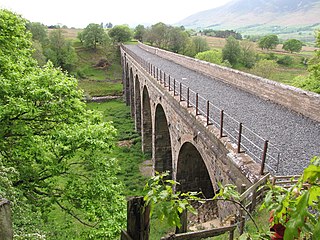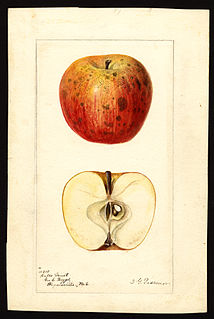| 'Keswick Codlin' | |
|---|---|
 | |
| Genus | Malus |
| Species | M. domestica |
| Cultivar | 'Keswick Codlin' |
| Origin | Lancashire, England, pre 1793 [1] |
'Keswick Codlin' is an apple cultivar that is considered excellent for cooking, but does not keep well in storage. [2]
| 'Keswick Codlin' | |
|---|---|
 | |
| Genus | Malus |
| Species | M. domestica |
| Cultivar | 'Keswick Codlin' |
| Origin | Lancashire, England, pre 1793 [1] |
'Keswick Codlin' is an apple cultivar that is considered excellent for cooking, but does not keep well in storage. [2]

In computer science, garbage collection (GC) is a form of automatic memory management. The garbage collector, or just collector, attempts to reclaim garbage, or memory occupied by objects that are no longer in use by the program. Garbage collection was invented by American computer scientist John McCarthy around 1959 to simplify manual memory management in Lisp.

Keswick is an English market town and a civil parish, historically in Cumberland, and since 1974 in the Borough of Allerdale in Cumbria. Lying within the Lake District National Park, Keswick is just north of Derwentwater and is 4 miles (6.4 km) from Bassenthwaite Lake. It had a population of 5,243 at the 2011 census.

Allerdale is a non-metropolitan district of Cumbria, England, with borough status. Its council is based in Workington and the borough has a population of 93,492 according to the 2001 census, increasing to 96,422 at the 2011 Census.

A cooking apple or culinary apple is an apple that is used primarily for cooking, as opposed to a dessert apple, which is eaten raw. Cooking apples are generally larger, and can be tarter than dessert varieties. Some varieties have a firm flesh that does not break down much when cooked. Culinary varieties with a high acid content produce froth when cooked, which is desirable for some recipes. Britain grows a large range of apples specifically for cooking. Worldwide, dual-purpose varieties are more widely grown.

The Cockermouth, Keswick and Penrith Railway (CK&PR) was an English railway company incorporated by Act of Parliament on 1 August 1861, to build a line connecting the town of Cockermouth with the London and North Western Railway (LNWR) West Coast Main Line at Penrith. Arrangements for the use of the stations at either end were included. Passenger and goods traffic was worked by the LNWR and mineral traffic by the North Eastern Railway, both of whom had shares in the company. The line was 31 1⁄2 miles (50.7 km) in length, and had eight intermediate stations.

Keswick is an inner south-western suburb of Adelaide, adjacent to the park lands, and located in the City of West Torrens. The suburb is home to the Keswick Barracks, the headquarters of the Royal District Nursing Service, and the Keswick Cricket Club.

'Ralls Janet' is an apple cultivar that is also known by many other names. It has been used extensively in modern apple breeding, and has several commercially important offspring. It was grown at Monticello by Thomas Jefferson. It has been said that the name derives from Edmond-Charles Genet, a Frenchman who gave cuttings to Thomas Jefferson, who then passed them on to Virginia nurseryman M. Caleb Ralls, but this claim was not made until about 100 years after the apple became known and may not be accurate.

The Cars of the Stars Motor Museum was in the English town of Keswick, Cumbria, and owned a collection of celebrity television and film vehicles. The museum opened in 1989 and closed in 2011. The sister site The Bond Museum in Keswick, with its over 30 original screen cars from the James Bond films, also closed at the same time.

Keswick is an unincorporated community in Albemarle County, Virginia, United States, about six miles east of Charlottesville.
Keswick Ridge is a Canadian rural community in York County, New Brunswick on Route 616.

Esopus Spitzenburg or Aesopus Spitzenburgh is a variety of apple. It was discovered early in the 18th century near Esopus, New York and is reputed to have been a favorite apple of Thomas Jefferson, who planted several of the trees at Monticello.

Applethwaite is a village in the foothills of Skiddaw near Keswick in the English Lake District. It is in the Borough of Allerdale and the county of Cumbria, and forms part of the civil parish of Underskiddaw, which has a population of 282. The name derives from it originally being the clearing in a forest with apples in it.

Keswick Museum is a local museum based in Keswick in the English Lake District, which exhibits aspects of the landscape, history and culture of the area.

Bismarck is an apple cultivar. The fruit from the tree is used for cooking due to its sharp flavour and is most commonly pureed when cooking.

Yellow Bellflower is a cultivar of domesticated apple that originated in New Jersey. It has many other names including "Belle Flavoise" and "Lincoln Pippin". It is probably the best known of a group of apple cultivars referred to as the yellow bellflower group, with fruit that are generally elongated, with largely yellow skin. Along with the Yellow Bellflower, the Ortley is the oldest of the group.

Manks Codlin is an early cultivar selected from the domesticated apple that were growing at Isle of Man. It has many other names, including 'Winter Saint Lawrence' and 'Eva'. It first fruited in 1815. This cultivar is considered particularly cold hardy and well suited to exposed sites and poor soils.

Wolf River is an American cultivar of domesticated apple, which originates from the shores of the Wolf River of Wisconsin, in the United States of America, known since 1875. The tree is exceptionally frost hardy and generally disease resistant, and thus keeps well in storage. The fruit usually ripens mid-September to early October. It is large, commonly weighing over a pound, and fairly sweet with a distinctive red and yellow appearance. It has many culinary uses, as it keeps its shape well when cooked.

Liveland Raspberry or Lowland Raspberry is an old cultivar of domesticated apple, first recorded before 1870, that originated from the Livland Governorate of eastern Europe and was introduced into the United States of America in 1883. It is a very early ripening apple.

The Oare Pavilion or Oare Tea House Pavilion is a summer house designed by I. M. Pei for the businessman Henry Keswick and his wife Tessa Keswick at Oare House in Oare, Wiltshire. It was completed in 2003 and is Pei's only building in the United Kingdom. The pavilion was the recipient of an award from the Georgian Society for a new building in a Georgian context.